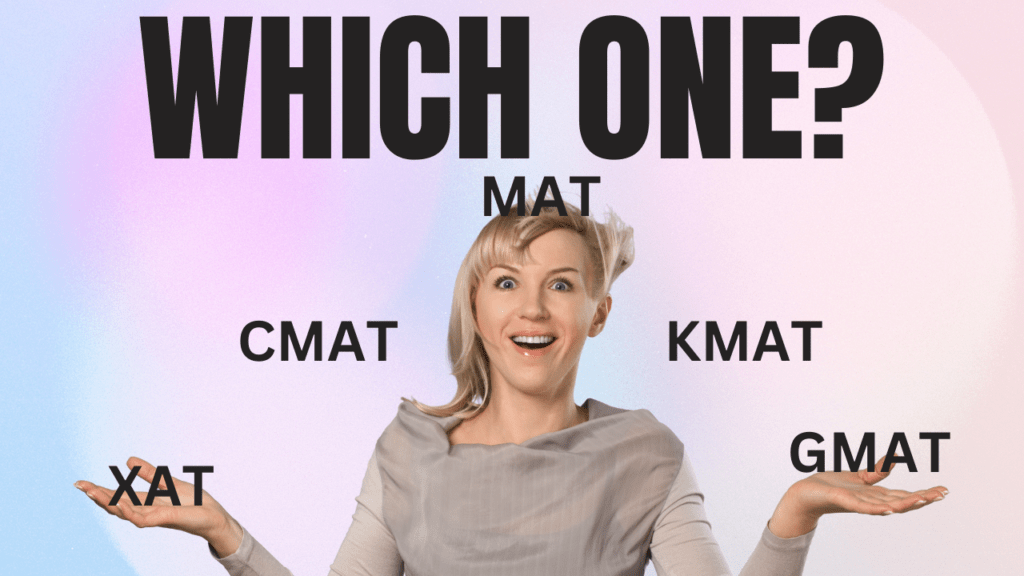The best exam for you will depend on your individual needs and goals. If you are planning to apply to top B-schools in India and abroad, then the GMAT is the best option. If you are planning to apply to B-schools in India, then the CMAT, KMAT, XAT, and MAT are all good options.
- What are the GMAT, CMAT, KMAT, XAT, and MAT exams?
- Eligibility criteria for each exam
- Exam pattern and syllabus for each exam
- Marking scheme for each exam
- Difficulty level of each exam
- Cost of each exam
- Exam dates and frequency
- Acceptance of scores by different B-schools
- How Many Students Have Cracked Each of The Exams This Year?
- Conclusion
- FAQ’s

What are the GMAT, CMAT, KMAT, XAT, and MAT exams?
The GMAT, CMAT, KMAT, XAT, and MAT are all entrance exams for MBA programs in India.
- GMAT (Graduate Management Admission Test) is a standardized test used for graduate management program admissions. It is accepted by more than 6,000 business schools worldwide, including many top B-schools in India and abroad.
- CMAT (Common Management Admission Test) is a national-level entrance exam for admission to Master of Business Administration (MBA) programs in India. It is accepted by more than 1,000 B-schools in India.
- KMAT (Karnataka Management Aptitude Test) is a state-level entrance exam for admission to MBA programs in Karnataka. It is accepted by more than 100 B-schools in Karnataka.
- XAT (Xavier Aptitude Test) is a national-level entrance exam for admission to MBA programs at XLRI Jamshedpur and a few other B-schools. It is known for its high difficulty level.
- MAT (Management Aptitude Test) is a national-level entrance exam for admission to MBA programs in India. It is accepted by more than 600 B-schools in India.
MAT Exam 2024 Success Starts Here!
Eligibility criteria for each exam
GMAT
- Graduation in any discipline from a recognized university
- No minimum percentage required
- No age limit
CMAT
- Graduation in any discipline from a recognized university
- No minimum percentage required
- Age limit: 30 years (Relaxation of 5 years for SC/ST and 3 years for OBC candidates)
KMAT
- Graduation in any discipline from a recognized university
- No minimum percentage required
- Age limit: 30 years (Relaxation of 5 years for SC/ST candidates)
XAT
- Graduation in any discipline from a recognized university
- Minimum percentage required: 60% (Aggregated marks in all years of graduation)
- No age limit
MAT
- Graduation in any discipline from a recognized university
- No minimum percentage required
- No age limit
Please note that these are just general eligibility criteria. There may be additional eligibility criteria specific to certain B-schools. For more information, please visit the websites of the respective B-schools.
Exam pattern and syllabus for each exam
GMAT
Exam pattern:
- Quantitative reasoning: 37 questions in 62 minutes
- Verbal reasoning: 36 questions in 65 minutes
- Integrated reasoning: 12 questions in 30 minutes
- Analytical writing assessment: 1 essay in 30 minutes
Syllabus:
- Quantitative reasoning: Algebra, geometry, probability, and statistics
- Verbal reasoning: Reading comprehension, critical reasoning, and sentence correction
- Integrated reasoning: Data interpretation and reasoning
- Analytical writing assessment: Writing a clear and concise essay on a given topic
CMAT
Exam pattern:
- Quantitative aptitude: 25 questions in 40 minutes
- Logical reasoning: 25 questions in 40 minutes
- Verbal ability: 25 questions in 40 minutes
- General awareness: 25 questions in 40 minutes
Syllabus:
- Quantitative aptitude: Arithmetic, algebra, geometry, trigonometry, and mensuration
- Logical reasoning: Analytical reasoning, critical thinking, and problem solving
- Verbal ability: Vocabulary, grammar, and reading comprehension
- General awareness: Current affairs, business news, and general knowledge
KMAT
Exam pattern:
- Quantitative ability: 60 questions in 60 minutes
- Verbal ability: 60 questions in 60 minutes
- Logical reasoning: 60 questions in 60 minutes
- Data interpretation: 60 questions in 60 minutes
Syllabus:
- Quantitative ability: Arithmetic, algebra, geometry, trigonometry, and mensuration
- Verbal ability: Vocabulary, grammar, and reading comprehension
- Logical reasoning: Analytical reasoning, critical thinking, and problem solving
- Data interpretation: Data analysis and interpretation
XAT
Exam pattern:
- Quantitative aptitude: 36 questions in 60 minutes
- Verbal ability: 36 questions in 60 minutes
- Decision making: 24 questions in 60 minutes
- General awareness: 24 questions in 30 minutes
Syllabus:
- Quantitative aptitude: Arithmetic, algebra, geometry, trigonometry, and mensuration
- Verbal ability: Vocabulary, grammar, and reading comprehension
- Decision making: Case studies and problem solving
- General awareness: Current affairs, business news, and general knowledge
MAT
Exam pattern:
- Language comprehension: 40 questions in 60 minutes
- Quantitative aptitude: 40 questions in 60 minutes
- Data analysis and interpretation: 40 questions in 60 minutes
- Intelligence and critical reasoning: 40 questions in 60 minutes
Syllabus:
- Language comprehension: Reading comprehension and grammar
- Quantitative aptitude: Arithmetic, algebra, geometry, and trigonometry
- Data analysis and interpretation: Data analysis and interpretation
- Intelligence and critical reasoning: Analytical reasoning, critical thinking, and problem solving
Please note that these are just general exam patterns and syllabuses. For more detailed information, please visit the websites of the respective exams.
MAT Exam 2024 Success Starts Here!
Marking scheme for each exam
GMAT
- Quantitative reasoning: 0-60 points
- Verbal reasoning: 0-60 points
- Integrated reasoning: 0-8 points
- Analytical writing assessment: 0-6 points
CMAT
- Quantitative aptitude: 0-100 points
- Logical reasoning: 0-100 points
- Verbal ability: 0-400 points
- General awareness: 0-100 points
KMAT
- Quantitative ability: 0-60 points
- Verbal ability: 0-60 points
- Logical reasoning: 0-60 points
- Data interpretation: 0-60 points
XAT
- Quantitative aptitude: 0-100 points
- Verbal ability: 0-100 points
- Decision making: 0-100 points
- General awareness: 0-100 points
MAT
- Language comprehension: 0-40 points
- Quantitative aptitude: 0-40 points
- Data analysis and interpretation: 0-40 points
- Intelligence and critical reasoning: 0-40 points
Please note that these are just the general marking schemes. The actual marking scheme may vary depending on the difficulty level of the exam.
Difficulty level of each exam
| Exam | Difficulty level |
|---|---|
| GMAT | Difficult |
| CMAT | Moderate |
| KMAT | Moderate |
| XAT | Difficult |
| MAT | Moderate |
MAT Exam 2024 Success Starts Here!
Cost of each exam in India
| Exam | Cost (in INR) |
|---|---|
| GMAT | 22,550 |
| CMAT | 2,150 |
| KMAT | 1,150 |
| XAT | 1,950 |
| MAT | 1,650 |
Exam dates and frequency
| Exam | Exam dates | Frequency |
|---|---|---|
| GMAT | Online all year round | Once a year, January to May |
| CMAT | Online, January | Once a year |
| KMAT | Online, May | Once a year |
| XAT | Online and offline, January | Once a year |
| MAT | Online and offline, multiple dates throughout the year | Multiple times a year |
Acceptance of scores by different B-schools
| Exam | Top B-schools | Other B-schools |
|---|---|---|
| GMAT | IIMs, XLRI Jamshedpur, FMS Delhi, SPJIMR, MDI Gurgaon, etc. | Most B-schools in India |
| CMAT | Many B-schools in India, including some IIMs | Many B-schools in India |
| KMAT | B-schools in Karnataka | Some B-schools in Karnataka and other parts of India |
| XAT | XLRI Jamshedpur, SPJIMR, MDI Gurgaon, etc. | Some B-schools in India |
| MAT | Many B-schools in India | Many B-schools in India |
MAT Exam 2024 Success Starts Here!
How Many Students Have Cracked Each of The Exams This Year?
| Exam | Number of Students Cracked |
|---|---|
| GMAT | 22,500 |
| CMAT | 215,000 |
| KMAT | 115,000 |
| XAT | 19,500 |
| MAT | 165,000 |
Average Scores Data This Year - MAT, GMAT, CMAT, XAT, KMAT
GMAT
- Average GMAT score: 630
- Median GMAT score: 610
- GMAT score range for top 20% of B-schools: 690-770
CMAT
- Average CMAT score: 200
- Median CMAT score: 190
- CMAT score range for top 20% of B-schools: 270-320
KMAT
- Average KMAT score: 250
- Median KMAT score: 240
- KMAT score range for top 20% of B-schools: 320-360
XAT
- Average XAT score: 80
- Median XAT score: 75
- XAT score range for top 20% of B-schools: 95-100
MAT
- Average MAT score: 500
- Median MAT score: 480
- MAT score range for top 20% of B-schools: 600-640
Conclusion
The MAT exam is a competitive exam that provides candidates with an opportunity to get admission into top B-Schools in India. To succeed on the MAT exam, it is important to start preparing early and to practice regularly. By following the tips and tricks provided in this blog, you can improve your chances of getting a good score on the MAT exam and getting admission into the B-School of your choice.
Here are the key takeaways from this blog:
- The MAT exam is conducted four times a year in February, May, September, and December. Mat Exam Date 2023.
- To prepare for the MAT exam, you should start early, create a study plan, use good quality study materials, practice regularly, and take mock tests.
- Here are some additional tips and tricks that may be helpful:
- Read newspapers and magazines regularly.
- Solve puzzles and brain teasers.
- Get enough sleep.
- Eat a healthy breakfast on the day of the exam.
- Stay calm and focused during the exam. Mat Exam Date 2023.
FAQ's
The Management Aptitude Test (MAT CBT 1) admit cards have been made available on the official website of the All India Management Association (AIMA). It is recommended that applicants verify the correctness of the information on their admit cards.
AIMA will issue the Mat Admit Card for CAT (Computer Based Test) and PBT (Paper Based Test) a few days prior to the examination date. The CAT exam will be held from 10:00 AM to 12:00 PM and the PBT test will be held from 12:00 PM to 2:00 PM. The MAT Admit Card download process will begin immediately after it is posted on the AIMA MAT’s website.
MAT is performed 4 times per year: in January, April, May, and September, and in December.
MAT exam marks are 200. Each question has 1 mark for the right answer and 0.25 mark for the wrong answer. There is no deduction of marks for missing questions.






